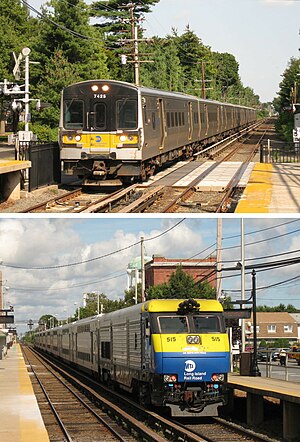
Back Long Island Rail Road Danish Long Island Rail Road German Ferrocarril de Long Island Spanish Long Island Rail Road Estonian Long Island Railroad French Long Island Rail Road ID Long Island Rail Road Italian ロングアイランド鉄道 Japanese 롱아일랜드 철도 Korean Long Island Rail Road Dutch
| Long Island Rail Road | |||
|---|---|---|---|
 The Long Island Rail Road provides electric and diesel rail service from east to west throughout Long Island. | |||
| Overview | |||
| Owner | Metropolitan Transportation Authority (MTA) | ||
| Locale | Long Island and Manhattan, New York | ||
| Transit type | Commuter rail | ||
| Number of lines | 11 | ||
| Number of stations | 126 | ||
| Daily ridership | 276,800 (weekdays, Q3 2024)[1] | ||
| Annual ridership | 75,186,900 (2023)[2] | ||
| Chief executive | Robert Free | ||
| Headquarters | Jamaica station, Jamaica, New York, U.S. | ||
| Website | new | ||
| Operation | |||
| Began operation | 1834 | ||
| Operator(s) | Metropolitan Transportation Authority | ||
| Reporting marks | LI | ||
| Technical | |||
| System length | 319 mi (513 km) (route); 700 mi (1,100 km) (total track length) | ||
| Track gauge | 4 ft 8+1⁄2 in (1,435 mm) standard gauge | ||
| Electrification | Third rail, 750 V DC | ||
| Top speed | 80 mph (130 km/h)[3] | ||
| |||
The Long Island Rail Road (reporting mark LI), or LIRR, is a railroad in the southeastern part of the U.S. state of New York, stretching from Manhattan to the eastern tip of Suffolk County on Long Island. The railroad currently operates a public commuter rail service, with its freight operations contracted to the New York and Atlantic Railway. With an average weekday ridership of 354,800 passengers in 2016, it is the busiest commuter railroad in North America.[4][5] It is also one of the world's few commuter systems that runs 24/7 year-round.[6] It is publicly owned by the Metropolitan Transportation Authority, which refers to it as MTA Long Island Rail Road. In 2023, the system had a ridership of 75,186,900, or about 276,800 per weekday as of the third quarter of 2024.
The LIRR logo combines the circular MTA logo with the text Long Island Rail Road, and appears on the sides of trains. The LIRR is one of two commuter rail systems owned by the MTA, the other being the Metro-North Railroad in the northern suburbs of the New York area. Established in 1834 (the first section between the Brooklyn waterfront and Jamaica opened on April 18, 1836) and having operated continuously since then, it is the oldest railroad in the United States still operating under its original name and charter.[7][8][9]
There are 126 stations and more than 700 miles (1,100 km) of track[9] on its two main lines running the full length of the island and eight major branches, with the passenger railroad system totaling 319 route miles (513 km).[10] As of 2018[update], the LIRR's budget for expenditures was $1.6 billion plus $450 million for debt service, which it supports through the collection of fares (which cover 43% of total expenses) along with dedicated taxes and other MTA revenue.[11][12]
- ^ "Transit Ridership Report Third Quarter 2024" (PDF). American Public Transportation Association. November 20, 2024. Retrieved November 23, 2024.
- ^ "Transit Ridership Report Fourth Quarter 2023" (PDF). American Public Transportation Association. March 4, 2024. Retrieved September 5, 2024.
- ^ @LIRR (October 13, 2015). "The max allowable service speed for LIRR trains is 80 mph. But how fast are they DESIGNED to go? #TriviaTuesday" (Tweet). Retrieved July 2, 2018 – via Twitter.
- ^ "Transit Ridership Report Fourth Quarter and End-of-Year 2016" (PDF). American Public Transportation Association (APTA). March 16, 2017. Archived from the original (PDF) on March 20, 2017. Retrieved March 20, 2017.
- ^ "MTA – Transportation Network". mta.info. Archived from the original on June 3, 2019. Retrieved September 16, 2014.
- ^ "MTA – Transportation Network". mta.info. Archived from the original on June 3, 2019. Retrieved September 16, 2014.
- ^ "LIRR History". mta.info. Metropolitan Transportation Authority (MTA). Archived from the original on June 29, 2013. Retrieved March 1, 2013.
- ^ "MTA Long Island Rail Road". Metropolitan Transportation Authority. Archived from the original on March 11, 2020. Retrieved April 21, 2020.
- ^ a b "Long Island Rail Road – General Information". Metropolitan Transportation Authority (MTA). Archived from the original on February 2, 2007. Retrieved March 23, 2014.
- ^ "Comprehensive Annual Financial Report for the Years Ended December 31, 2012 and 2011" (PDF). Metropolitan Transportation Authority (MTA). June 21, 2013. p. 146. Archived (PDF) from the original on July 4, 2019. Retrieved August 29, 2014.
- ^ Rivoli, Dan (February 13, 2018). "MTA Budget: Where does the money go?". NY Daily News. Archived from the original on November 3, 2018. Retrieved November 3, 2018.
- ^ Brennan, Jim. "LIRR's Heavy Subsidies and the Coming Debate Over MTA Funding", Gotham Gazette, January 10, 2019. Accessed March 9, 2022. "The data show the LIRR farebox will contribute 43.4% of the LIRR's operating costs in 2019 and declines to about 38% by 2022.... This analysis shows that the Long Island Rail Road's deficit is $1.345 billion a year and is more than 18% of the MTA's total deficit, although its fare and other operating revenue provide about 12% of the MTA's total revenue."
